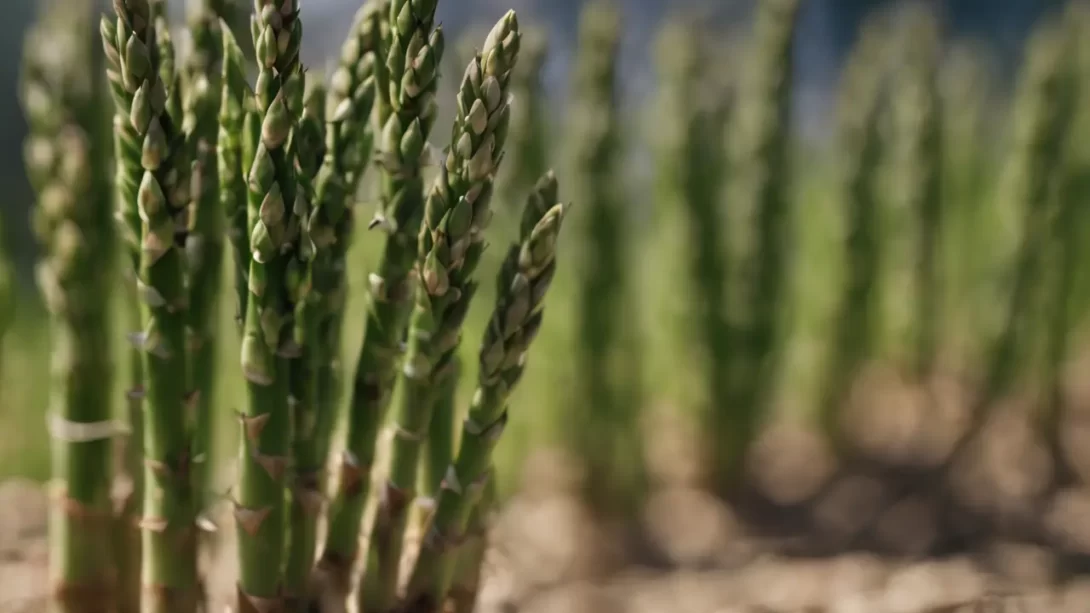Asparagus, a popular perennial vegetable, is a staple in many home gardens. Its cultivation is unique due to its perennial nature, requiring gardeners to understand the plant’s long-term growth, including its root system. This article aims to shed light on the depth and structure of asparagus roots, providing essential information for those looking to plant and care for asparagus effectively.
Asparagus Plants
Asparagus plants are known for their longevity, often producing for 15 years or more. They grow from a central root system, known as a crown, which develops into a network of roots and fern-like above-ground growth. This perennial cycle means that the health of the root system is crucial for the plant’s yearly productivity. A well-established root system not only supports annual spear production but also ensures the overall vitality of the plant.
Characteristics of Asparagus Roots
Asparagus roots are fibrous and extensive, growing outward and downward from the crown. They are integral to the plant’s ability to absorb water and nutrients from the soil. These roots also store energy during the photosynthesis process, which is vital for spear production in the subsequent growing season. The root system’s health directly influences the quality and quantity of asparagus spears that the plant can produce.
In different asparagus varieties, there can be variations in root structure and behavior. However, all asparagus plants share a common need for a deep, well-developed root system to thrive.
Depth of Asparagus Roots
The roots of asparagus plants can grow quite deep. In optimal growing conditions, asparagus roots can extend to a depth of 6 to 10 feet. However, the majority of the root system typically resides within the top 12 inches of soil. This extensive root depth is beneficial for the plant as it allows access to a greater volume of soil nutrients and moisture, contributing to the health and productivity of the asparagus.
Factors Influencing Root Depth
Several factors can influence the depth and development of asparagus roots:
- Soil Type: Sandy or loamy soils that are well-drained encourage deeper root growth. In contrast, clay-heavy or compacted soils can restrict root expansion and depth.
- Moisture Levels: Asparagus roots tend to grow deeper in search of moisture in drier soil conditions. Consistent, deep watering encourages deeper root growth, whereas shallow watering can lead to shallower root systems.
- Plant Age: Mature asparagus plants typically have deeper and more extensive root systems compared to newly planted or young plants.
Implications for Planting and Maintenance
Understanding the depth of asparagus roots has important implications for planting and caring for asparagus:
- Planting Depth: Asparagus crowns should be planted in trenches deep enough to accommodate root expansion, typically about 6-8 inches deep.
- Soil Preparation: Prior to planting, soil should be loosened and amended to a depth that supports deep root growth, encouraging the roots to grow downward.
- Spacing: Adequate spacing between plants is crucial to allow for the extensive root system to develop without competition for nutrients and water.
Planting and Caring for Asparagus
For successful cultivation, it’s crucial to consider the needs of the asparagus root system:
- Soil Preparation: Prepare a deep, well-drained planting bed. Adding organic matter can improve soil structure and nutrient availability for the roots.
- Planting Technique: Place crowns in trenches and gradually fill in soil as the shoots grow, encouraging roots to grow deeper.
- Watering Practices: Deep watering encourages the roots to grow downward, while avoiding waterlogged conditions which can be detrimental to root health.
Challenges and Solutions Related to Root Depth
While deep roots are beneficial for asparagus, certain challenges can arise:
- Shallow Root Development: Poor soil conditions or inadequate watering can lead to shallow root systems. This can make plants more susceptible to drought and nutrient deficiencies.
- Root Competition: In gardens with mixed plantings, asparagus can face competition for nutrients and water. This competition can inhibit the growth of a deep and healthy root system.
- Soil Compaction: Over time, soil can become compacted, hindering root growth. This is particularly problematic in heavy clay soils.
Strategies for Mitigating Root-Related Problems
To address these challenges:
- Soil Aeration: Regularly aerate the soil to prevent compaction, especially in heavier soils. This can be done using a garden fork or aeration tools.
- Appropriate Fertilization: Apply well-balanced fertilizers that cater to the needs of asparagus, particularly phosphorus, which promotes root growth.
- Mulching: Use organic mulch to maintain soil moisture and temperature, reduce weed competition, and improve soil structure over time.
Preventing Maggot Infestations
Preventative measures are key in maintaining a healthy asparagus garden:
- Regular Monitoring: Keep an eye on the plants for signs of stress or poor growth, which can indicate root problems.
- Proper Planting and Spacing: Give asparagus plants enough space to grow. This prevents overcrowding and ensures each plant has sufficient access to nutrients and water.
- Maintaining Plant Health: Healthy plants are better equipped to develop robust root systems. This includes proper watering, fertilizing, and disease management.
Conclusion
The root system of asparagus is a critical component of the plant’s overall health and productivity. Understanding the depth and requirements of asparagus roots is essential for anyone looking to grow this vegetable successfully. Challenges related to root depth can be mitigated with proper soil preparation, care, and maintenance practices. By creating optimal conditions for root growth, gardeners can enjoy bountiful asparagus harvests for many years. Remember, a healthy root system is the foundation of a thriving asparagus plant, and attention to these details will yield significant rewards in your garden.



